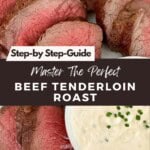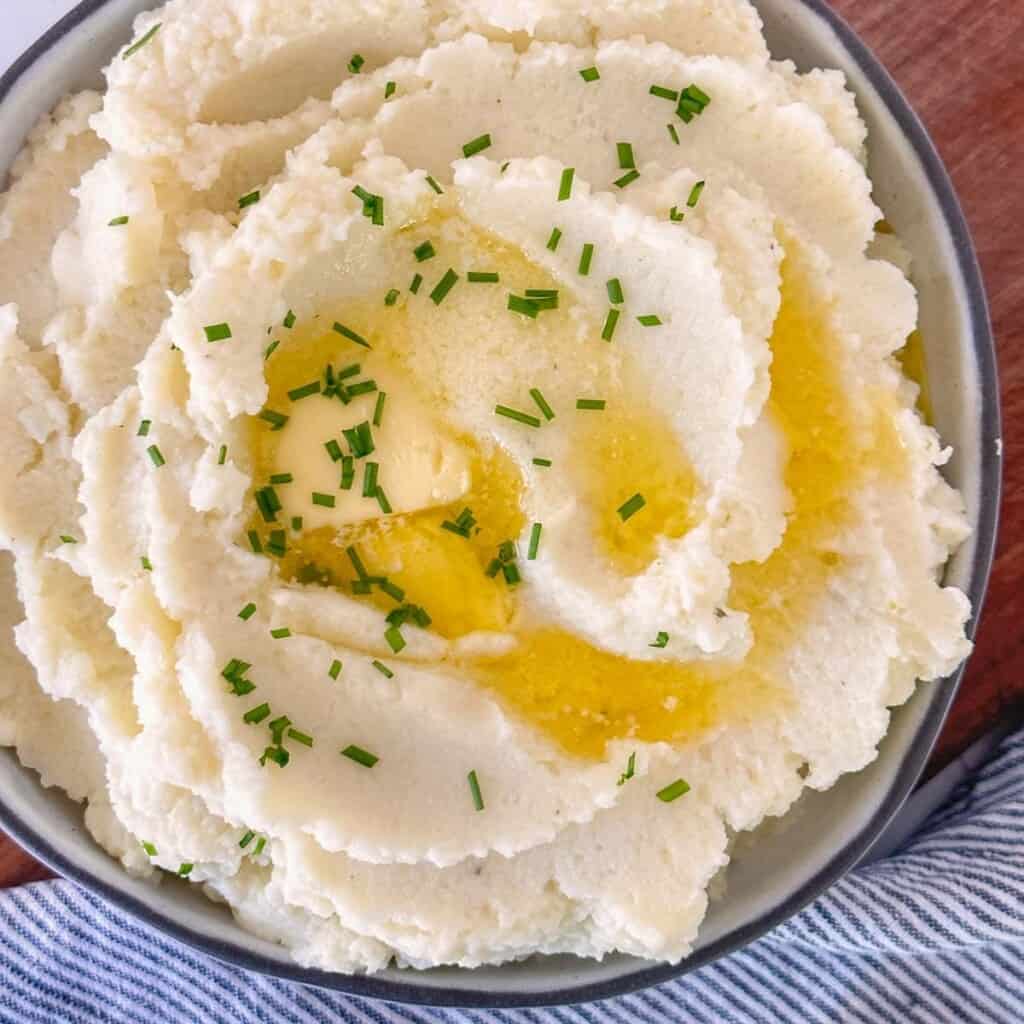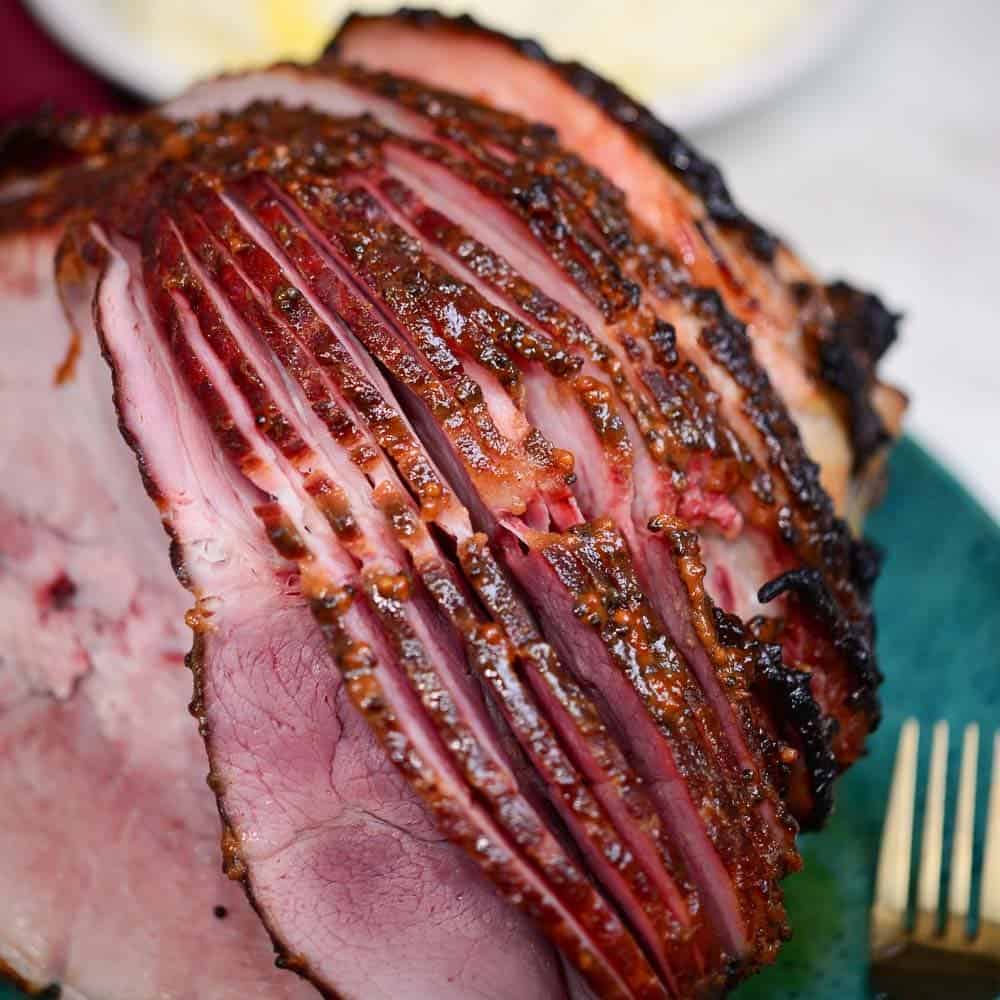Beef Tenderloin Roast
When treating your taste buds to the epitome of indulgence, few dishes rival the elegance and flavor of a perfectly cooked beef tenderloin roast.
This classic centerpiece is more than just a meal – it’s a culinary masterpiece that transforms special occasions into a memorable gastronomic affair. It’s the perfect holiday main dish as impressive as a traditional prime rib roast.

This comprehensive guide will walk you through mastering a beef tenderloin roast that’s a tender, juicy, and savory delight.
Whether you’re a seasoned chef or a passionate home cook, our step-by-step instructions and tips and tricks will ensure you can craft an exceptional beef tenderloin roast with resounding success.
recipe Techniques That Work
What Is a Beef Tenderloin?
Beef tenderloin, often called “Filet Mignon,” is renowned for its unmatched tenderness and buttery texture. This coveted cut comes from the loin region of the cow, and its lean yet marbled nature makes it a prime choice for a roast that promises melt-in-your-mouth perfection.
The tenderloin roast is an impressive holiday centerpiece roast.

A full beef tenderloin roast is comprised of three distinctive parts
- Filet mignon steaks are cut from the thick end of the tenderloin roast.
- Chateaubriand is the center cut of the tenderloin. This part of the roast has the most flavor but still maintains the prized tenderness of the filet. When cooking for a smaller group, I ask the butcher to give me the Chateaubriand roast or the center cut of the beef tenderloin roast.
- Beef tips: The end portion of the beef tenderloin is usually used when you see a recipe for beef tips. This part of the roast can’t be used for steak cuts, so it is an affordable way to enjoy this tender cut of beef.

How To Prepare Beef Tenderloin Recipe

How To Cook Roast Beef Tenderloin
There are many ways to cook a beef tenderloin roast. After much research, I am using J. Kenji Lopez-Alt’s method for slow-roasting this beef tenderloin at a low temperature. This method produces a flavorful and perfectly evenly cooked tenderloin roast.
Roasting at a high temperature yields a roast that is more well done around the outside. Because the tenderloin roast is a leaner cut of meat this well-done temperature is less than optimal for producing the best flavor. In general, leaner cuts of beef should be left rarer, with medium-rare being the most done that is recommended.
A fattier cut, such as a prime-rib, can be cooked to medium-rare or even medium and still have a great flavor and mouthfeel.
What Temperature To Cook Beef Tenderloin?
To slow-roast beef tenderloin, it will be cooked at 225℉ for 2 to 3 hours, depending on its size.
Cooking Temperature Chart
What Temperature Should Beef Tenderloin Be?
The internal temperature of this beef tenderloin roast should be 120℉ (49℃) when it is removed from the oven. This will allow for a little extra cooking as you develop the outer crust with seasoned butter.
After searing the roast, either under the broiler or in a skillet the internal temperature will rise to 125℉ (52℃) for rare and 130℉ (54℃) for medium rare.
There is no need to rest this roast before slicing. Normally a roast like a prime rib might rest for up to an hour before slicing.
Using a meat thermometer is crucial. Without a probe thermometer you cannot accurately measure the internal temperature.
What To Serve with Beef Tenderloin
My favorite thing to serve with a beef roast is a Horseradish Cream Recipe.

Cauliflower Mash
Creamy Cucumber Salad
Cheesy Scalloped Potatoes
Summer Orzo Salad
More Beef Recipes
Pot Roast Recipe
Japanese Beef Curry Recipe – Easy & Delicious
Korean Short Ribs [Galbi Jjim]
How to Cook the Perfect Steak Every Time – Pan-Seared, Grilled, or Oven-Finished!
Guinness Braised Beef Short Ribs
Slow Roasted Beef Tenderloin
Equipment
- kitchen twine (affiliate link)
- cast iron pan (affiliate link)
- probe thermometer (affiliate link)
- wire rack (affiliate link)
- heavy rimmed baking sheet (affiliate link)
Ingredients
- 2 to 3 lbs beef tenderloin roast, full roast or center cut [note 1]
- kosher salt (affiliate link)
- freshly ground black pepper (affiliate link)
Seasoned Herb Butter
- unsalted butter, [note 2]
- fresh thyme
- fresh rosemary
- shallot
- garlic
For Serving
- fresh chives, finely minced
- fleur de sel (affiliate link), or maldon salt
- Horseradish Cream
Instructions
- The day before: Prepare the roast by tying it with butcher's string and seasoning it well with salt and pepper. Place the seasoned roast on a wire rack set over a heavy baking sheet. Place the roast into the fridge and let it sit overnight to dry brine. [note 3]
- When you're ready to cook: Place the oven rack in the center position of the oven. Preheat the oven to 225℉ (107℃). Place the roast in the oven and cook until the internal temperature reaches 120℉ (49℃).
- Rest for 10 minutes: Remove the roast from the oven and set it aside to rest for 10 minutes. Remove the butcher's twine and get ready to finish the roast in a skillet or under the broiler.
- Prepare the herb butter: Add the butter to a skillet and heat over medium heat until the butter is lightly browned. Add the fresh herbs and the shallots.
- To finish in the skillet: Add the roast to the skillet, and use a spoon to distribute the butter over the roast. Turn the roast every 30 seconds until you have a nicely browned outer crust. It takes about 1 to 2 minutes. The internal temperature should be 125℉ (52℃) for rare and 130℉ (54℃) for medium rare.
- To finish under the broiler: Adjust the oven rack to sit 6 inches from the broiler. Pour over the butter and herb mixture. Place the roast under the broiler. Turn the roast every 30 seconds until you have a nicely browned outer crust. It takes about 1 to 2 minutes. The internal temperature should be 125℉ (52℃) for rare and 130℉ (54℃) for medium rare.
- Resting: Because this roast is slow-roasted at a lower temperature, it does not need to have s significant resting time before slicing.
- Serve: Serve with Horseradish Cream Sauce, fresh chives and a sprinkle of coarse salt, such as fleur de sel or Maldon salt.
Laura’s Tips + Notes
- I used the center cut for this recipe. However, this recipe can be made with a whole tenderloin roast (serves 10 to 12) or the smaller center-cut chateaubriand (serves 4 to 6). Ask your butcher to trim the roast to save time.
- You can vary the fresh herbs that are used for the herb butter. The browned butter gives the roast a beautiful color and flavor.
- The overnight dry brining serves two purposes. It dries out the outside of the roast to encourage better browning and adds flavor through osmotic diffusion.
YOUR OWN NOTES
Sign In to add your own private notes

























